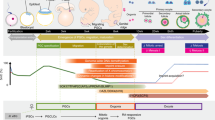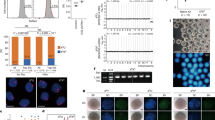Abstract
Oogenesis is an integrated process through which an egg acquires the potential for totipotency, a fundamental condition for creating new individuals. Reconstitution of oogenesis in a culture that generates eggs with proper function from pluripotent stem cells (PSCs) is therefore one of the key goals in basic biology as well as in reproductive medicine. Here we describe a stepwise protocol for the generation of eggs from mouse PSCs, such as embryonic stem cells (ESCs) and induced pluripotent stem cells (iPSCs). ESCs and iPSCs are first induced into primordial germ cell–like cells (PGCLCs) that are in turn aggregated with somatic cells of female embryonic gonads, the precursors for adult ovaries. Induction of PGCLCs followed by aggregation with the somatic cells takes up to 8 d. The aggregations are then transplanted under the ovarian bursa, in which PGCLCs grow into germinal vesicle (GV) oocytes in ∼1 month. The PGCLC-derived GV oocytes can be matured into eggs in 1 d by in vitro maturation (IVM), and they can be fertilized with spermatozoa by in vitro fertilization (IVF) to obtain healthy and fertile offspring. This method provides an initial step toward reconstitution of the entire process of oogenesis in vitro.
This is a preview of subscription content, access via your institution
Access options
Subscribe to this journal
Receive 12 print issues and online access
$259.00 per year
only $21.58 per issue
Buy this article
- Purchase on Springer Link
- Instant access to full article PDF
Prices may be subject to local taxes which are calculated during checkout




Similar content being viewed by others
References
Sasaki, H. & Matsui, Y. Epigenetic events in mammalian germ-cell development: reprogramming and beyond. Nat. Rev. Genet. 9, 129–140 (2008).
Ewen, K.A. & Koopman, P. Mouse germ cell development: from specification to sex determination. Mol. Cell Endocrinol. 323, 76–93 (2010).
Saitou, M. & Yamaji, M. Germ cell specification in mice: signaling, transcription regulation, and epigenetic consequences. Reproduction 139, 931–942 (2010).
Lawson, K.A. et al. Bmp4 is required for the generation of primordial germ cells in the mouse embryo. Genes Dev. 13, 424–436 (1999).
Hilscher, B. et al. Kinetics of gametogenesis. I. Comparative histological and autoradiographic studies of oocytes and transitional prospermatogonia during oogenesis and prespermatogenesis. Cell Tissue Res. 154, 443–470 (1974).
Speed, R.M. Meiosis in the foetal mouse ovary. I. An analysis at the light microscope level using surface-spreading. Chromosoma 85, 427–437 (1982).
Edson, M.A., Nagaraja, A.K. & Matzuk, M.M. The mammalian ovary from genesis to revelation. Endocr. Rev. 30, 624–712 (2009).
Campbell, K.H., McWhir, J., Ritchie, W.A. & Wilmut, I. Sheep cloned by nuclear transfer from a cultured cell line. Nature 380, 64–66 (1996).
Wakayama, T., Perry, A.C., Zuccotti, M., Johnson, K.R. & Yanagimachi, R. Full-term development of mice from enucleated oocytes injected with cumulus cell nuclei. Nature 394, 369–374 (1998).
Hayashi, K., Ohta, H., Kurimoto, K., Aramaki, S. & Saitou, M. Reconstitution of the mouse germ cell specification pathway in culture by pluripotent stem cells. Cell 146, 519–532 (2011).
Hayashi, K. et al. Offspring from oocytes derived from in vitro primordial germ cell-like cells in mice. Science 338, 971–975 (2012).
Hubner, K. et al. Derivation of oocytes from mouse embryonic stem cells. Science 300, 1251–1256 (2003).
Toyooka, Y., Tsunekawa, N., Akasu, R. & Noce, T. Embryonic stem cells can form germ cells in vitro. Proc. Natl. Acad. Sci. USA 100, 11457–11462 (2003).
Geijsen, N. et al. Derivation of embryonic germ cells and male gametes from embryonic stem cells. Nature 427, 148–154 (2004).
Nayernia, K. et al. In vitro–differentiated embryonic stem cells give rise to male gametes that can generate offspring mice. Dev. Cell 11, 125–132 (2006).
Tesar, P.J. et al. New cell lines from mouse epiblast share defining features with human embryonic stem cells. Nature 448, 196–199 (2007).
Hayashi, K. & Surani, M.A. Self-renewing epiblast stem cells exhibit continual delineation of germ cells with epigenetic reprogramming in vitro. Development 136, 3549–3556 (2009).
Saitou, M., Kagiwada, S. & Kurimoto, K. Epigenetic reprogramming in mouse pre-implantation development and primordial germ cells. Development 139, 15–31 (2012).
Chuma, S. et al. Spermatogenesis from epiblast and primordial germ cells following transplantation into postnatal mouse testis. Development 132, 117–122 (2005).
Matoba, S. & Ogura, A. Generation of functional oocytes and spermatids from fetal primordial germ cells after ectopic transplantation in adult mice. Biol. Reprod. 84, 631–638 (2011).
Hashimoto, K., Noguchi, M. & Nakatsuji, N. Mouse offspring derived from fetal ovaries or reaggregates which were cultured and transplanted into adult females. Dev. Growth Differ. 34, 233–238 (1992).
Ying, Q.L., Nichols, J., Chambers, I. & Smith, A. BMP induction of Id proteins suppresses differentiation and sustains embryonic stem cell self-renewal in collaboration with STAT3. Cell 115, 281–292 (2003).
Brons, I.G. et al. Derivation of pluripotent epiblast stem cells from mammalian embryos. Nature 448, 191–195 (2007).
Guo, G. et al. Klf4 reverts developmentally programmed restriction of ground state pluripotency. Development 136, 1063–1069 (2009).
Ohinata, Y. et al. A signaling principle for the specification of the germ cell lineage in mice. Cell 137, 571–584 (2009).
Ohinata, Y., Sano, M., Shigeta, M., Yamanaka, K. & Saitou, M. A comprehensive, non-invasive visualization of primordial germ cell development in mice by the Prdm1-mVenus and Dppa3-ECFP double transgenic reporter. Reproduction 136, 503–514 (2008).
Ying, Q.L. et al. The ground state of embryonic stem cell self-renewal. Nature 453, 519–523 (2008).
Nagy, A., Gertsenstein, M., Vintersten, K. & Behringer, R. Manipulating the Mouse Embryo 3rd edn. (Cold Spring Harbor Laboratory Press, 2003).
Acknowledgements
We would like to thank S. Ogushi, K. Kurimoto, H. Ohta, S. Shimamoto, S. Aramaki and Y. Ishikura for their technical assistance, and T. Mori for encouragement. We also thank S. Matoba and A. Ogura for their advice on ovary reconstitution. This study was supported in part by a Grant-in-Aid from the Ministry of Education, Culture, Sports, Science and Technology of Japan; by JST-PRESTO/Core Research for Evolutionary Science and Technology (CREST)/ERATO; and by the Takeda Science Foundation.
Author information
Authors and Affiliations
Contributions
K.H. and M.S. conceived of the study; K.H. performed the experiments; K.H. and M.S. wrote the manuscript.
Corresponding authors
Ethics declarations
Competing interests
The authors declare no competing financial interests.
Rights and permissions
About this article
Cite this article
Hayashi, K., Saitou, M. Generation of eggs from mouse embryonic stem cells and induced pluripotent stem cells. Nat Protoc 8, 1513–1524 (2013). https://doi.org/10.1038/nprot.2013.090
Published:
Issue Date:
DOI: https://doi.org/10.1038/nprot.2013.090
Comments
By submitting a comment you agree to abide by our Terms and Community Guidelines. If you find something abusive or that does not comply with our terms or guidelines please flag it as inappropriate.



